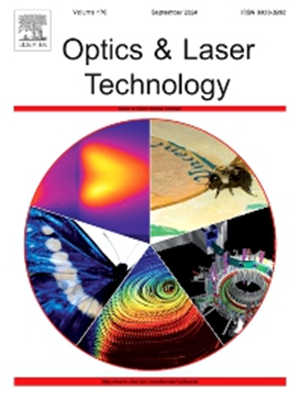掺杂 C 和 N 的 CsZnBr3 卤化物包晶的热电和光电特性,可用于自旋过滤器和高效节能设备
IF 4.6
2区 物理与天体物理
Q1 OPTICS
引用次数: 0
摘要
本研究主要报告了 CsZnBr3 卤化物包晶的热电性质和光学性质,随后在密度泛函理论框架内使用全电势线性化增强平面波方法报告了其结构、电子和磁性能。此外,我们还分析了 C 和 N 对 CsZnBr3 的电子结构、磁性、热电和光学特性的影响。在最佳条件下,CsZnBr3 显示出非磁性相,有趣的是,在掺入 C 和 N 后,CsZnBr2C 和 CsZnBr2C 变成了铁磁性,磁矩分别为 3.0 和 2.0 μB。此外,半导体 CsZnBr3 具有自旋滤波半导体性质,其能带隙分别为:CsZnBr2C 1.38↑ 和 3.26↓ eV,CsZnBr2N 2.72↑ 和 1.67↓ eV。这些掺杂材料可用作自旋电子学中的自旋滤波器件,从而降低功耗,提高电子器件的能效。利用 BoltzTrap 代码估算了塞贝克系数、功率因数、热导率和优点系数等热电参数。结果发现,在高温条件下,CsZnBr2C 的优点值从 0.88 提高到了 1.06,这表明它在热电应用方面具有潜力。在光学参考中,光子能量可在紫外线区域被吸收。本文章由计算机程序翻译,如有差异,请以英文原文为准。
Thermoelectric and optoelectronic features of C- and N- doped CsZnBr3 halide perovskite for use in spin filter and energy efficient devices
Present study reports mainly thermoelectric and optical properties followed by its structural, electronic, magnetic properties of CsZnBr3 halide perovskite using full potential linearized augmented plane wave method in the framework of density functional theory. Further we analyzed the impact of C and N on CsZnBr3 for their electronic structure, magnetic nature, thermoelectric, and optical properties. CsZnBr3 under optimum conditions exhibits a non-magnetic phase, which interestingly upon doping of C and N, turns out to be ferromagnetic with magnetic moments of 3.0 and 2.0 μB for CsZnBr2C and CsZnBr2C, respectively. Furthermore, Semiconducting CsZnBr3 exhibits spin filter semiconductor nature with energy band gaps of 1.38↑ and 3.26↓ eV for CsZnBr2C and 2.72↑ and 1.67↓ eV for CsZnBr2N. These doped materials can be used in spintronics as spin-filter devices for lower power consumption leading to more energy-efficient electronics. The thermoelectric parameters as Seebeck coefficient, power factor, thermal conductivity and figure of merit are estimated using BoltzTrap code. The figure of merit value found enhanced from 0.88 to 1.06 with one orientation of spins for CsZnBr2C at high temperature, which suggests its potential use in thermoelectric applications. In optical reference photon energy can be absorbed in UV-region.
求助全文
通过发布文献求助,成功后即可免费获取论文全文。
去求助
来源期刊
CiteScore
8.50
自引率
10.00%
发文量
1060
审稿时长
3.4 months
期刊介绍:
Optics & Laser Technology aims to provide a vehicle for the publication of a broad range of high quality research and review papers in those fields of scientific and engineering research appertaining to the development and application of the technology of optics and lasers. Papers describing original work in these areas are submitted to rigorous refereeing prior to acceptance for publication.
The scope of Optics & Laser Technology encompasses, but is not restricted to, the following areas:
•development in all types of lasers
•developments in optoelectronic devices and photonics
•developments in new photonics and optical concepts
•developments in conventional optics, optical instruments and components
•techniques of optical metrology, including interferometry and optical fibre sensors
•LIDAR and other non-contact optical measurement techniques, including optical methods in heat and fluid flow
•applications of lasers to materials processing, optical NDT display (including holography) and optical communication
•research and development in the field of laser safety including studies of hazards resulting from the applications of lasers (laser safety, hazards of laser fume)
•developments in optical computing and optical information processing
•developments in new optical materials
•developments in new optical characterization methods and techniques
•developments in quantum optics
•developments in light assisted micro and nanofabrication methods and techniques
•developments in nanophotonics and biophotonics
•developments in imaging processing and systems

 求助内容:
求助内容: 应助结果提醒方式:
应助结果提醒方式:


